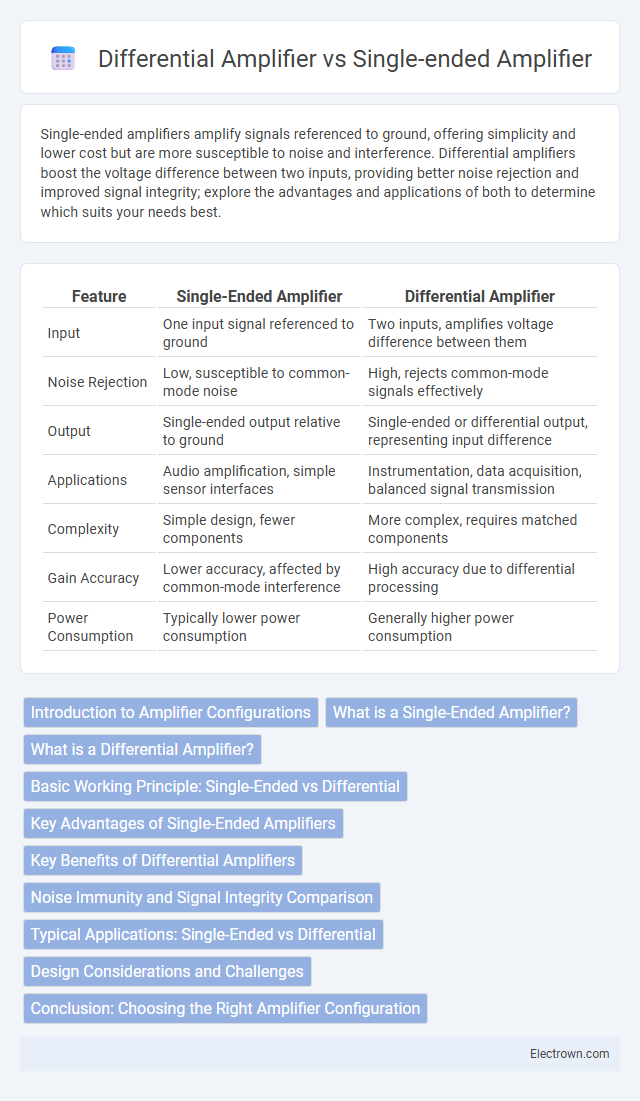Single-ended amplifiers amplify signals referenced to ground, offering simplicity and lower cost but are more susceptible to noise and interference. Differential amplifiers boost the voltage difference between two inputs, providing better noise rejection and improved signal integrity; explore the advantages and applications of both to determine which suits your needs best.
Table of Comparison
| Feature | Single-Ended Amplifier | Differential Amplifier |
|---|---|---|
| Input | One input signal referenced to ground | Two inputs, amplifies voltage difference between them |
| Noise Rejection | Low, susceptible to common-mode noise | High, rejects common-mode signals effectively |
| Output | Single-ended output relative to ground | Single-ended or differential output, representing input difference |
| Applications | Audio amplification, simple sensor interfaces | Instrumentation, data acquisition, balanced signal transmission |
| Complexity | Simple design, fewer components | More complex, requires matched components |
| Gain Accuracy | Lower accuracy, affected by common-mode interference | High accuracy due to differential processing |
| Power Consumption | Typically lower power consumption | Generally higher power consumption |
Introduction to Amplifier Configurations
Single-ended and differential amplifier configurations serve distinct roles in signal processing, with single-ended amplifiers amplifying voltage relative to a common ground, ideal for applications with low noise requirements. Differential amplifiers, by contrast, amplify the difference between two input signals, providing superior noise rejection and enhanced signal integrity, crucial in environments with significant electromagnetic interference. Understanding these configurations helps ensure Your design leverages the appropriate amplifier type for optimal performance and noise immunity in various electronic circuits.
What is a Single-Ended Amplifier?
A single-ended amplifier amplifies an input signal referenced to a common ground, producing an output voltage relative to that ground. It uses one active device, such as a transistor or operational amplifier, to boost the signal amplitude. Single-ended amplifiers are simpler in design but more susceptible to noise and interference compared to differential amplifiers.
What is a Differential Amplifier?
A differential amplifier amplifies the voltage difference between two input signals, rejecting any voltage common to both inputs, known as common-mode signals. This design enhances noise immunity and accuracy, making differential amplifiers essential in applications like sensor signal processing and audio equipment. Understanding your signal's differential nature helps in selecting the right amplifier to improve performance and reduce interference.
Basic Working Principle: Single-Ended vs Differential
Single-ended amplifiers operate by amplifying a single input signal referenced to ground, making them simpler but more susceptible to noise and interference. Differential amplifiers amplify the voltage difference between two input signals, enhancing noise rejection and improving signal integrity in noisy environments. Your choice depends on the application requirements for noise immunity and signal accuracy.
Key Advantages of Single-Ended Amplifiers
Single-ended amplifiers offer simplicity in design and lower cost compared to differential amplifiers, making them ideal for applications where noise immunity is less critical. They require fewer components and less complex circuitry, which contributes to reduced power consumption and easier troubleshooting. Your choice of a single-ended amplifier can enhance efficiency in projects demanding straightforward amplification with minimal signal processing.
Key Benefits of Differential Amplifiers
Differential amplifiers offer superior noise rejection due to their ability to amplify the difference between two input signals while minimizing common-mode noise, enhancing signal integrity in your applications. They provide higher input impedance and improved linearity compared to single-ended amplifiers, resulting in better accuracy and performance in sensitive measurements. These amplifiers also support balanced signal transmission, reducing electromagnetic interference and making them ideal for professional audio and communication systems.
Noise Immunity and Signal Integrity Comparison
Differential amplifiers offer superior noise immunity compared to single-ended amplifiers by rejecting common-mode noise and interference present on both input lines, ensuring higher signal integrity in noisy environments. Single-ended amplifiers are more susceptible to electromagnetic interference and ground loop noise, which can degrade signal quality and accuracy. Your choice between these amplifiers affects the reliability of signal transmission, especially in applications requiring precise and clean analog signals.
Typical Applications: Single-Ended vs Differential
Single-ended amplifiers are commonly used in applications such as audio amplification and radio receivers where simplicity and cost-effectiveness are priorities. Differential amplifiers excel in environments requiring noise rejection and signal integrity, including instrumentation, sensor signal processing, and balanced audio systems. Your choice depends on whether you need to amplify a single input signal with minimal complexity or manage two complementary signals for improved performance.
Design Considerations and Challenges
Single-ended amplifiers require careful biasing and are more susceptible to noise and distortion due to their single reference point, demanding precise component matching for optimal performance. Differential amplifiers offer improved noise rejection and linearity by amplifying the voltage difference between two inputs, but their design challenges include ensuring balanced impedance and managing common-mode signals effectively. Your choice between these amplifier types hinges on balancing complexity, noise tolerance, and signal integrity requirements in your specific application.
Conclusion: Choosing the Right Amplifier Configuration
Choosing the right amplifier configuration depends on your specific application requirements, such as noise immunity, signal integrity, and complexity. Single-ended amplifiers are simpler and cost-effective for low-noise, short-distance signals, while differential amplifiers excel in rejecting common-mode noise and improving signal quality in noisy environments. Evaluating these factors ensures optimal performance and reliability for your electronic design.
Single-ended vs differential amplifier Infographic

 electrown.com
electrown.com